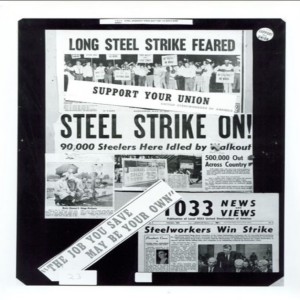
On this day in labor history, the year was 1959.
That was the day half a million steel workers walked off the job in a historic, 116-day strike to defend work rules.
It was the largest industry-wide strike and also the last.
The strike affected 12 steel companies and shut down more than 85% of steel production. Mill owners refused to grant wage increases unless the union agreed to changes in the contract.
Specifically, they were looking to eliminate Section 2 (b), titled “Local Working Conditions.”
The bosses wanted the ability to change the number of workers assigned to any given task.
They also wanted to introduce machinery and rules that would reduce labor hours and cut the work force.
USWA members understood this as an assault on workplace safety and a move to break the union.
Mill bosses hoped that a long strike would provoke the membership to abandon their union.
But, according to Jack Metzgar, author of Striking Steel, members had grown used to walkouts every 3 years and planned accordingly.
As well, the USW had a “well-oiled machinery including an internal welfare system for hardship cases and also reached out to merchants, banks, charitable agencies, and local and state governments” to organize relief.
By the end of August, the Defense Department stoked anxieties that national security was at risk.
Three months into the strike, union funds dwindled. Strikers felt the pinch.
President Eisenhower invoked a Taft-Hartley injunction, hoping to force strikers back to work.
As the union rose to challenge Taft-Hartley’s constitutionality, solidarity among the mill owners crumbled.
Kaiser Steel broke ranks and settled separately.
Their contract granted wage increases and preserved section 2(b).
It set the precedent for the contract that was eventually signed industry-wide.
More Episodes
 2023-10-27
2023-10-27
 2023-10-26
2023-10-26
 2023-10-26
2023-10-26
 2023-10-24
2023-10-24
 2023-10-22
2023-10-22
 2023-10-21
2023-10-21
 2023-10-19
2023-10-19
 2023-10-18
2023-10-18
 2023-10-17
2023-10-17
 2023-10-16
2023-10-16
 2023-10-15
2023-10-15
 2023-10-12
2023-10-12
 2023-10-11
2023-10-11
 2023-10-09
2023-10-09
 2023-10-09
2023-10-09
Create your
podcast in
minutes
- Full-featured podcast site
- Unlimited storage and bandwidth
- Comprehensive podcast stats
- Distribute to Apple Podcasts, Spotify, and more
- Make money with your podcast
It is Free
- Privacy Policy
- Cookie Policy
- Terms of Use
- Consent Preferences
- Copyright © 2015-2024 Podbean.com




